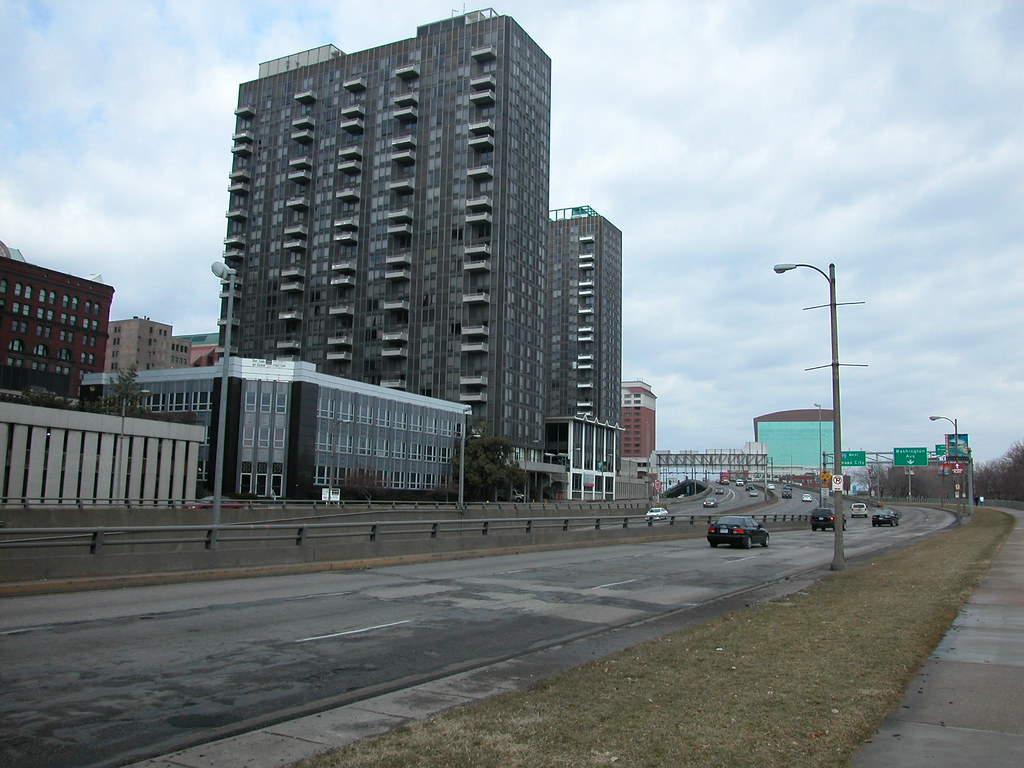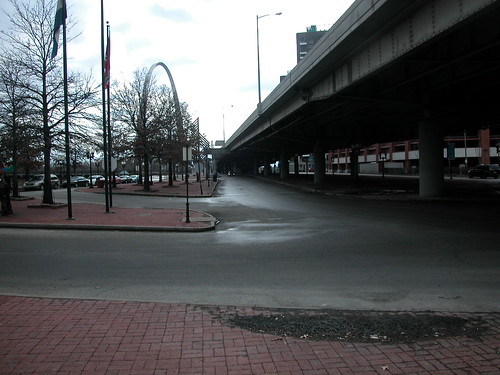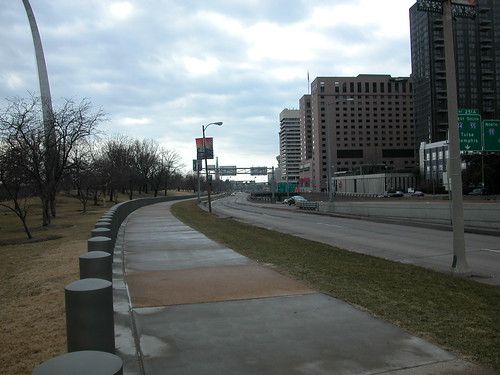 Six Case Studies in Freeway Removal is a an excellent overview of successful efforts to eliminate interstate highways in urban areas that created barriers. While there are examples from large cities like San Francisco, Toronto and Vancouver where one might expect progressive government, there are also studies from Milwaukee and Chattanooga where advocates for reconnecting the urban fabric faced greater odds.
Six Case Studies in Freeway Removal is a an excellent overview of successful efforts to eliminate interstate highways in urban areas that created barriers. While there are examples from large cities like San Francisco, Toronto and Vancouver where one might expect progressive government, there are also studies from Milwaukee and Chattanooga where advocates for reconnecting the urban fabric faced greater odds.There are constant themes in each project profiled in Six Case Studies in Freeway Removal: beautification and functionality were major goals of cities that removed freeways or freeway sections, spillover traffic was absorbed without major new congestion and freeway removal almost always lead to higher property values. St. Louis leaders contemplating the mess at the western edge of the Gateway Arch grounds ought to consider the findings of this study, and commission one aimed at the particular local problem that I-70 poses.

One of my first reactions to the case studies from other cities is that the I-70 problem is not that big. Taking the logical dimension of removal from the Poplar Street Bridge on the south to Cass Avenue on the north, one sees that we don't have as long or as vital a stretch of highway as other cities removed. What we will have in a few years, after the new river bridge opens, is a redundant second section of an interstate highway that disrupts the connection between downtown and the riverfront.
Is St. Louis ready to join the ranks of the cities that have found the leadership needed to think big? A few months ago, I might have been pessimistic. Now, I see that City Hall and many leaders are willing to take a major urban planning risk with McEagle Properties' NorthSide project. Putting aside the details of NorthSide, that project takes a leap of faith -- the scope is vast, the cost great and the potential for changing the central city tremendous. Part of the project even involves removing interstate highway infrastructure, the 22nd Street ramps connecting to Interstate 64. The project aims to capture southbound I-70 exit traffic and send it onto Tucker Boulevard, not eastward toward Memorial Drive. That flow could lessen traffic volume on the old I-70 and Memorial Drive.
 Is there a connection between NorthSide and removal of I-70 downtown? Not yeat, but there is a binding tendency in each project: big-picture economic development planning. While NorthSide's proponent is its developer, proponents of removing I-70 are citizens who see tremendous development opportunity along a human-scaled street. The removal of I-70 would weave the riverfront back into downtown, and it would create acres of land ripe for transformative downtown development. Like NorthSide, the process could take decades, but the results would be redevelopment on a scale beyond our wildest dreams. Add in the Chouteau Greenway project, and in thirty years Downtown could be ringed not by bleak interstate, asphalt parking and towing lots and vacant buildings but by connections to exciting new projects and renewed old neighborhoods.
Is there a connection between NorthSide and removal of I-70 downtown? Not yeat, but there is a binding tendency in each project: big-picture economic development planning. While NorthSide's proponent is its developer, proponents of removing I-70 are citizens who see tremendous development opportunity along a human-scaled street. The removal of I-70 would weave the riverfront back into downtown, and it would create acres of land ripe for transformative downtown development. Like NorthSide, the process could take decades, but the results would be redevelopment on a scale beyond our wildest dreams. Add in the Chouteau Greenway project, and in thirty years Downtown could be ringed not by bleak interstate, asphalt parking and towing lots and vacant buildings but by connections to exciting new projects and renewed old neighborhoods.Other cities took the leap of faith needed to set this level of vision into motion. Will St. Louis?





11 comments:
This is my first comment on this blog, but I feel qualified to offer an opinion on this. I've taken courses on traffic engineering and I also wrote a paper on the subject of freeway removal in school.
I didn't use this section of I-70 as an example or even consider it, but I did discover enough about the subject in general to learn that this idea is viable.
The volume of traffic carried by four interstate lanes (the depressed section) isn't very substantial. The traffic on these lanes could easily be absorbed by a 6-lane boulevard or even a 4-lane avenue with properly timed signals.
North of the depressed section becomes a bit more tricky, as the number of lanes go up to six. Studies would have to be performed to determined to see how much traffic could be diverted to the new bridge and how much would continue on to downtown. Existing surface traffic on Memorial Drive as well as traffic coming off the Eads and MLK Bridges.
Just eyeballing it tells me that it's all going to come back to how much traffic will go to the new bridge and how much can be absorbed into 4th, Broadway, and going farther north, Tucker (as mentioned in the main post.)
No offense meant, but I'd rather not defer to a traffic engineer regarding this project. It's a social decision and as the studies Michael cites demonstrate, traffic is most often absorbed beyond expectations.
Great post, Michael. I agree that the option of removing I-70 is becoming more and more possible. I've written a post advocating for better treatment of the current build environment and I think that do such could make the connection substantially better, but removal of the Interstate is clearly the superior option.
Michael -
Good post. An objective first step would be to complete a traffic study of the feasibility of such a plan.
Another interesting study would be to analyze the development potential and real estate benefits for created, and repositioned sites, like the Bottle District.
In a town loathe to change, interstate highway changes create perhaps the ultimate fear factor.
Look at the press hype surrounding the Highway 40 rebuild closures.
Then look at the reality of the situation. We fared much better than most everyone predicted.
Maybe there's a lesson for us from that experience.
Unfortunately, the freeway removal topic is like a political third rail...no one wants to take a chance on the idea. So your points about NorthSide are interesting ones.
Does NorthSide have better connectivity to downtown with a new Memorial Drive or the current I-70 configuration?
Still, the focus for such a vision needs to be wider, taking a regional perspective.
What about those South City and County drivers looking for fast and convenient access from Lambert Field to Lindbergh and 270? What happens to truck traffic?
What about the concern that removing the depressed lanes would limit access to downtown?
We need an economic impact study to determine whether interstate highway removals ever lead to a reduction in downtown property values or a loss of tax revenue to local government.
Such information would be as important to have as the results of a traffic study.
For advocates of interstate 70 removal to gain supporters, we will have to make the case in terms of dollars gained and overall economic development benefits for St. Louis.
RB
I think the highway 40 closure has proven that removing a major highway in the middle of a city is quite feasible. Of course, since St. Louisans are so adverse to change, many of those opposed to the closure told hideous tales of what would happen and what to expect, all of which never occured. I expect the same would happen if they thought about tearing out that section of 70, the vast majority of concern and commentary coming from those who would not even be affected by the new design.
Before construction started I was traveling from downtown all the way to O'Fallon on a regular basis several days a week for work. Traffic has surprisingly been a non-issue. Yes, there are places to avoid, but all in all I think getting around without 40 has been pretty manageable. Once the new bridge opens, I say get rid of that section of 70 and forget about it. We're all big boys and girls and I'm sure we can figure out alternative routes.
Yeah, my guess is the traffic study wouldn't predict well the actual future either. In Milwaukee everybody (including studies I believe) thought traffic would get worse and so on, but in fact congestion didn't change at all, if anything might of decreased.
What is the biggest impediment keeping this - elimination of the highway - from happening?
Is it simply money, or is it lack of vision?
It's much more than a social issue. TBTB would never sign off on the idea without a thorough study. Fears of traffic armageddon may not be realized, but the naysayers must be persuaded. The closure of 40 is temporary and I'm sure that is a big reason it was allowed to happen.
Don't get me wrong, I'd love to see the stretch from the Poplar Street Bridge to the New Bridge removed, but there are issues to be dealt with and accounted for. Lack of thorough planning in past projects is often bemoaned on this and other blogs. Yes, there is a certain margin of error in any study, but that doesn't discount the value of the study. The people holding the purse strings like them, and that's what matters.
Something else to keep in mind with most of the other examples of freeway removal (specifically Milwaukee and San Francisco) is that those freeways were smaller segments of a larger alignment that was never completed. They were basically marginally useful appendages that could never be fully utilized, so their removal wouldn't have the same impact as the removal of a through highway like I-70.
BTW, I'm not a traffic engineer by profession, I've only learned about it in school. Maybe someday I'll even stay at a Holiday Inn Express.
James--
This segment will become marginal with a new I-70 alignment. The current plan as I understand it is to turn the depressed section into a northward extension of I-44, connecting it with the new I-70. An interstate right-of-way seems unnecessary for this; a surface boulevard would do just fine in all likelihood. But bring on the study. I'ld like to see the results.
I-70 cut a whole in Denver as well, and suppressed real estate prices near and north of the elevated deck. It looks like it will soon be re-routed farther north, so Denver's older neighborhoods may be rejoined in 10 years or so.
Having visited St. Louis for months at a time in the past three years, I hope that one day I-70 and I-44 can be rerouted and the neighborhoods sewn back together. The damage done to Soulard and the Hill, not to mention the downtown area is still so obvious and atrocious.
What about I-55?
I take 55 to 70 everyday out to UMSL. I think the impact of closing it would be huge. From around 3 to 6 getting into the depressed section is a nightmare.
Also, they've destroyed stuff building the interstate, what would they destroy moving it?
What about the Churches that managed to survive the interstate building? Would they survive the move?
Snup - no buildings would be demolished, quite the contrary. Prime downtown real estate would be reclaimed for new development. The new roadway would be built within the current alignment.
In terms of traffic congestion through the depressed lanes, think of the area after the new I-70 Mississippi River bridge is opened.
All I-70 traffic will be removed from the depressed lanes, lowering traffic volume through that stretch.
This does not count the way traffic patterns are self healing after roadway changes. It is well established that downtown St. Louis already has excess road capacity.
The new Mississippi River Bridge and rerouting I-70 will increase options for drivers, as would improving Memorial Drive.
Post a Comment